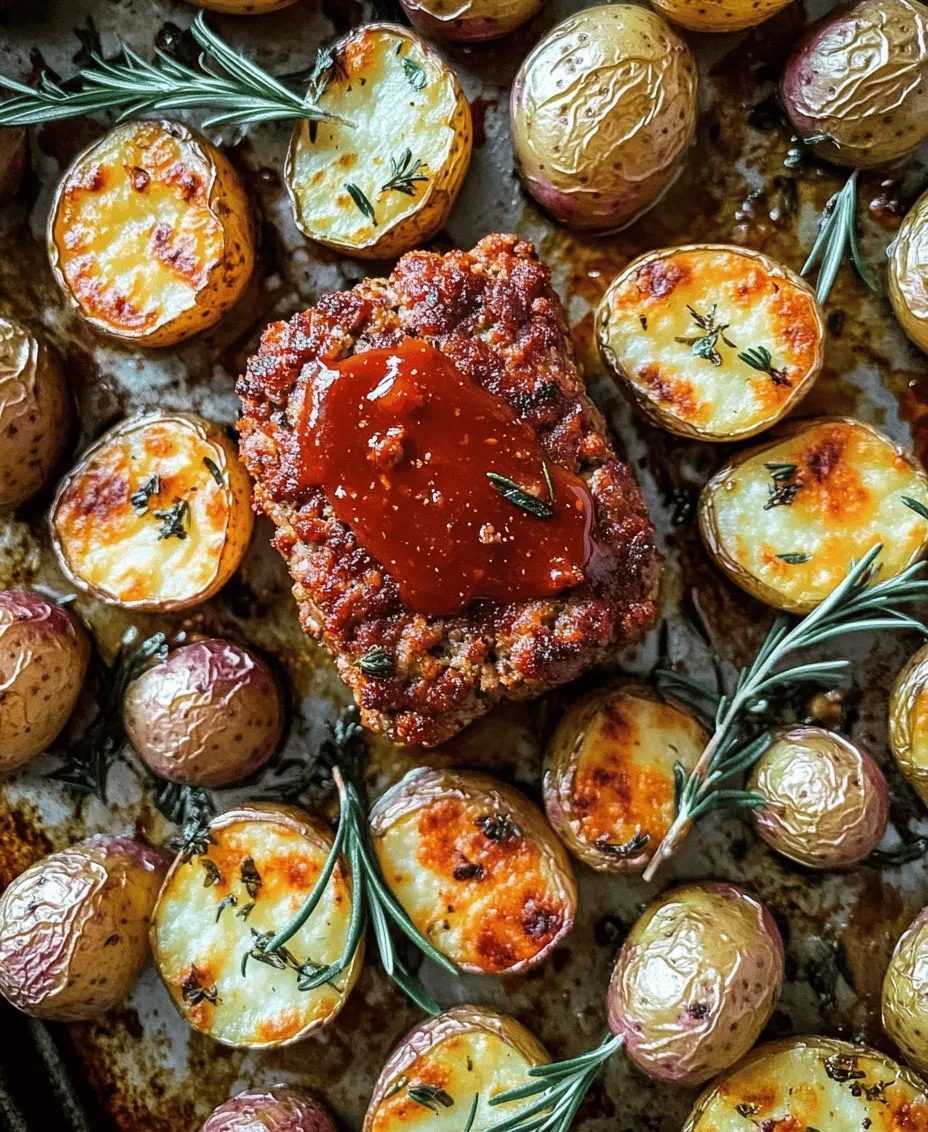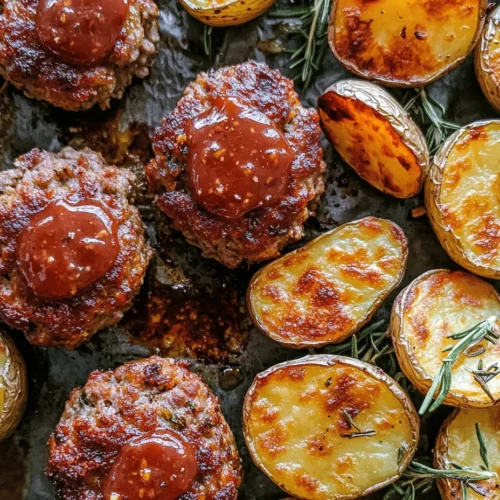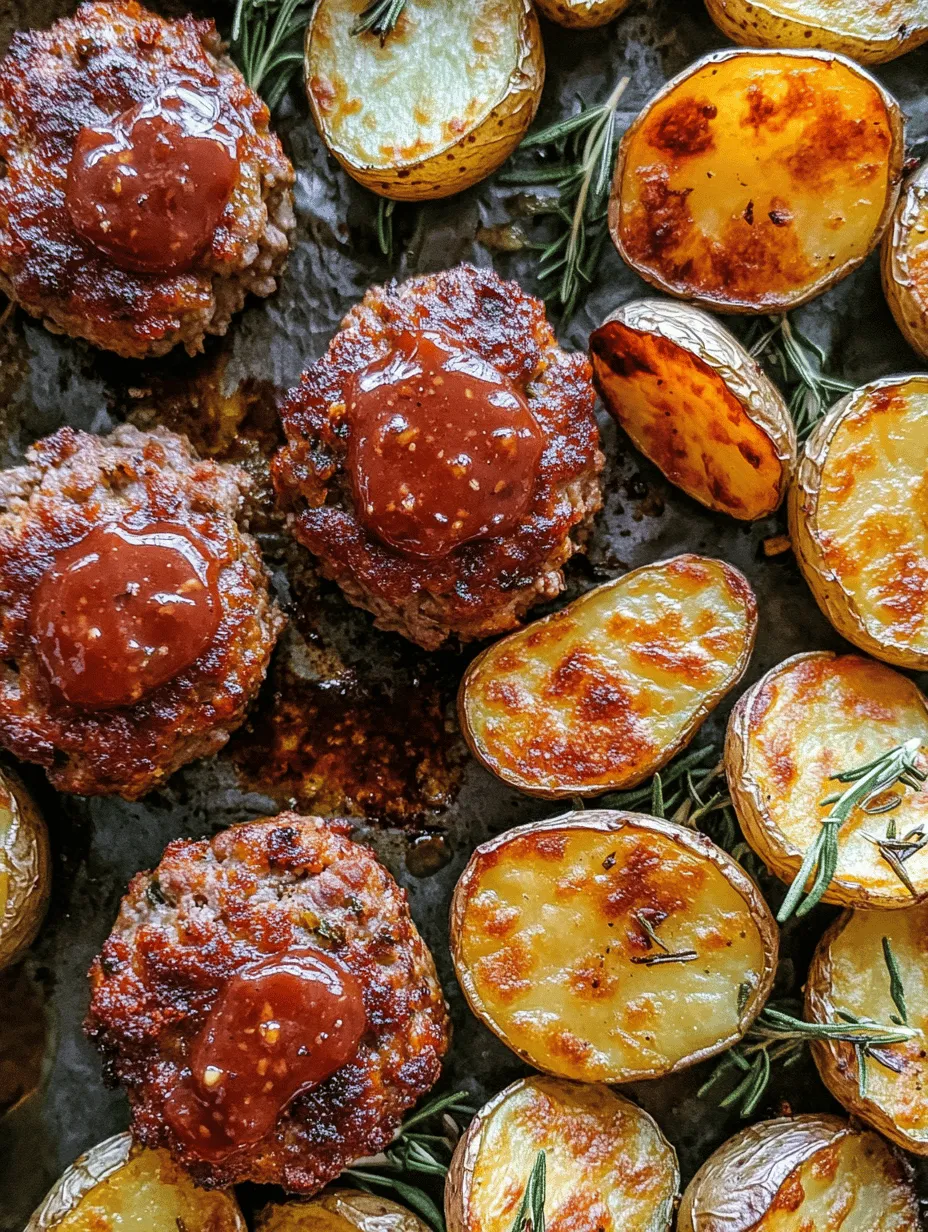Introduction
Savory Sheet Pan Mini Meatloaf & Crispy Roasted Potatoes is a delightful and practical dish that merges the comforting flavors of classic meatloaf with the crispy goodness of roasted potatoes—all prepared on a single baking sheet. This recipe not only streamlines your cooking process but also makes clean-up a breeze. Ideal for busy weeknights or a cozy family dinner, this dish is incredibly versatile, allowing for ingredient substitutions and variations to suit your dietary needs or personal preferences.
Imagine biting into a juicy, flavorful mini meatloaf, perfectly complemented by crispy, golden-brown potatoes. This meal is not just about taste; it embodies the essence of home-cooked comfort food. In this article, we will explore the ingredients that come together to create this delightful dish, provide detailed preparation steps, and discuss the benefits of preparing this meal.
Understanding the Savory Sheet Pan Mini Meatloaf
The mini meatloaf is a charming twist on traditional meatloaf, offering the same rich flavors in a portion-controlled format. Originating as a way to utilize leftover meats and household staples, meatloaf has long been a staple in American cuisine. Its roots can be traced back to ancient times, where similar mixtures were baked into loaves in various cultures, but it gained prominence in the United States during the Great Depression when frugality was essential.
Over the years, meatloaf has remained a beloved dish for many, often associated with warmth and family gatherings. The introduction of mini versions has gained traction in modern cooking, appealing to those looking for convenience and individualized servings. Mini meatloaves not only cook faster but also allow for creativity in flavors and ingredients, making them a perfect choice for families with varied tastes.
Ingredients Breakdown
To create the Savory Sheet Pan Mini Meatloaf & Crispy Roasted Potatoes, we will focus on selecting high-quality ingredients that enhance both flavor and texture. Here’s a closer look at the key components of the recipe.
Exploring the Meatloaf Ingredients
Ground Meat Choices: Beef vs. Turkey
The foundation of any meatloaf lies in the choice of ground meat. Traditional recipes often call for ground beef, which provides a rich and hearty flavor. However, for a lighter option, ground turkey is an excellent alternative, offering a leaner profile without sacrificing taste. You can also mix meats, using a combination of beef and turkey to achieve a balance of flavor and moisture.
The Role of Breadcrumbs in Binding
Breadcrumbs are essential in meatloaf recipes, acting as a binding agent that holds the ingredients together. They absorb moisture and help maintain the meatloaf’s structure while providing a tender texture. You can use traditional plain breadcrumbs or opt for seasoned varieties for an extra flavor kick. For gluten-free diets, crushed gluten-free crackers or almond flour can serve as suitable substitutes.
Enhancements from Cheese and Vegetables
Incorporating cheese and finely diced vegetables into the meatloaf mixture can elevate the dish. Cheese not only adds richness but also a creamy texture that complements the meat. Common choices include shredded cheddar or mozzarella. Vegetables, such as bell peppers, onions, or carrots, contribute moisture and nutrients, enhancing the flavor profile while keeping the meatloaf light and enjoyable.
Importance of Seasoning: Worcestershire Sauce, Herbs, and Spices
Seasoning is critical in achieving a flavorful meatloaf. Worcestershire sauce provides umami depth, while a blend of herbs and spices—such as garlic powder, onion powder, salt, pepper, and Italian herbs—can significantly enhance the overall flavor. Fresh herbs like parsley or thyme can also be added for a burst of freshness.
Exploring the Roasted Potatoes Ingredients
Baby Potatoes: Size and Varieties
When it comes to roasted potatoes, baby potatoes are the ideal choice. Their small size allows for even cooking and a delightful crispy exterior. Varieties such as Yukon Gold or red potatoes are excellent options, providing a creamy interior that contrasts beautifully with the crispy skin. For a more colorful presentation, consider using a mix of different potato varieties.
Choosing the Right Oils and Seasonings
The choice of oil is crucial for achieving perfectly roasted potatoes. Olive oil is a classic option that adds flavor and helps achieve a golden-brown crust. Alternatively, avocado oil is a great choice due to its high smoke point and mild flavor. Seasoning the potatoes with salt, pepper, and your preferred herbs will enhance their natural taste. Fresh rosemary or thyme can add an aromatic touch, while paprika can introduce a subtle smokiness.
The Impact of Fresh vs. Dried Herbs
While dried herbs can work well for seasoning, using fresh herbs can make a significant difference in the flavor of your roasted potatoes. Fresh herbs release essential oils during cooking, intensifying their aroma and taste. If using dried herbs, remember that they are more concentrated, so you’ll want to adjust the quantity accordingly.
Preparation Steps for Savory Sheet Pan Mini Meatloaf
To prepare the Savory Sheet Pan Mini Meatloaf & Crispy Roasted Potatoes, follow these detailed preparation steps that will ensure your meal is a success.
Prepping the Oven and Ingredients
How to Preheat the Oven Properly
Start by preheating your oven to 400°F (200°C). This high temperature is essential for achieving that desired crispy exterior on your roasted potatoes while ensuring the mini meatloaves cook through evenly. Preheating the oven allows for consistent cooking, so don’t skip this step.
Tips for Efficient Ingredient Prep
While the oven is preheating, gather and prepare all of your ingredients. This includes measuring out the ground meat, breadcrumbs, cheese, and vegetables for the meatloaf, as well as washing and cutting the baby potatoes. Having everything ready will streamline the cooking process and ensure you don’t miss any crucial steps.
Creating the Mini Meatloaf Mixture
Mixing Techniques to Avoid Overworking
In a large mixing bowl, combine your chosen ground meat, breadcrumbs, diced vegetables, shredded cheese, and seasonings. Using your hands or a spatula, gently mix the ingredients until just combined. Be careful not to overwork the meat mixture, as this can lead to a dense texture in the final product. The goal is to achieve a uniform mixture while still keeping the meatloaf light and tender.
Flavor Layering with Ingredients
As you mix the ingredients, think about layering flavors. For example, adding Worcestershire sauce early on will distribute its umami richness throughout the mixture. Consider incorporating some of the herbs and spices into the potato mixture as well to create a harmonious flavor profile across the entire dish.
Shaping and Arranging on the Sheet Pan
Once your meatloaf mixture is ready, it’s time to shape it into mini loaves. Use your hands to form small, oval-shaped loaves, roughly the size of your palm. This size ensures even cooking and makes it easy to serve.
Arrange the mini meatloaves on one side of a large, parchment-lined baking sheet. On the other side, place the prepared baby potatoes. Ensure there’s enough space between the meatloaves and potatoes to allow for proper roasting and to prevent steaming.
By following these steps, you’ll have a delicious and comforting meal ready to go in no time. The combination of savory mini meatloaves and crispy roasted potatoes will surely become a family favorite, perfect for any weeknight dinner or weekend gathering. In the next part of this article, we will explore cooking times, tips for achieving the best results, and common questions regarding this delightful recipe.

Best Practices for Shaping Mini Loaves
Shaping mini meatloaves can be a fun and creative part of the cooking process. To achieve the perfect mini loaves, a few best practices can help ensure they cook evenly and maintain their shape:
1. Use a Consistent Size: Aim to shape each mini loaf to be uniform in size, roughly 4-5 inches long and 2-3 inches wide. This ensures that they all cook at the same rate. You can use a measuring cup or your hands to portion out equal amounts of the meat mixture.
2. Moisten Your Hands: To prevent the meat mixture from sticking to your hands while shaping, consider moistening them slightly with water or oil. This will make it easier to form the loaves without losing any mixture to your fingers.
3. Don’t Overpack: While it’s important to make sure the loaves hold together, avoid packing the meat mixture too tightly. This can lead to dense meatloaves that aren’t as tender. Aim for a light but firm shape.
4. Create a Slight Indentation: Use your fingers to create a slight indentation on top of each mini loaf. This helps them cook evenly and allows heat to penetrate the center more effectively.
Strategically Placing Potatoes for Even Cooking
When preparing your sheet pan meal, the placement of the potatoes is crucial for achieving that perfect crispy texture. Here are some tips for strategically arranging them:
1. Cut Uniformly: Chop the potatoes into equal-sized pieces, about 1-1.5 inches in width. This ensures that they roast evenly, preventing some pieces from becoming soft while others remain undercooked.
2. Spacing Matters: Avoid overcrowding the pan. Leave some space between the potatoes and mini meatloaves to allow hot air to circulate freely. This enhances the roasting process and promotes crispiness.
3. Toss with Olive Oil: Before placing the potatoes on the sheet, toss them in olive oil, salt, and your choice of herbs. This not only adds flavor but also aids in achieving that desirable golden-brown crust.
Baking Process
The baking phase is where the magic happens, turning raw ingredients into a delicious and comforting meal. Paying attention to cooking times and temperatures is key to a successful dish.
Optimal Baking Temperature and Time
For the best results, preheat your oven to 400°F (200°C). This temperature is ideal for both the mini meatloaf and the potatoes, allowing them to brown beautifully while cooking through.
– Baking Time: Typically, you’ll want to bake the meatloaves and potatoes for about 25-30 minutes. It’s wise to check them a few minutes before the timer goes off.
Understanding the Science Behind Cooking Times
Cooking times can vary based on several factors, including the size of your meatloaves and the type of potatoes used. The meatloaf should reach an internal temperature of 160°F (71°C) for safe consumption. Using a meat thermometer can help you accurately gauge doneness.
How to Check for Doneness in Meatloaf
– Temperature Check: As mentioned, the most reliable way to check for doneness is by inserting a meat thermometer into the center of the largest mini loaf. If it reads 160°F (71°C), they are done.
– Visual Cues: In addition to temperature, look for a firm texture and a slightly browned exterior. If the juices run clear when you cut into a loaf, that’s another sign that they are ready.
Achieving Perfectly Roasted Potatoes
While the mini meatloaf is the star of the dish, perfectly roasted potatoes are the supporting act that can elevate the entire meal.
The Role of Olive Oil in Roasting
Olive oil not only adds flavor but also helps in achieving a crispy texture. It coats the potatoes, allowing them to brown evenly and enhancing their natural sweetness. A light tossing of the potatoes in olive oil ensures each piece is coated without being overly greasy.
Tips for Ensuring Crispy Texture
1. Preheat the Baking Sheet: An underrated tip is to preheat your baking sheet while the oven is warming up. This initial heat can kickstart the crisping process as soon as the potatoes hit the pan.
2. Avoid Overcrowding: Just as with the meatloaf, giving the potatoes space to breathe will prevent steaming, which can lead to soggy results. A single layer works best for crispiness.
3. Flip Halfway Through: About halfway through baking, carefully turn the potatoes with a spatula to ensure all sides get that beautiful golden color.
Serving Suggestions
The presentation of your Savory Sheet Pan Mini Meatloaf and Crispy Roasted Potatoes can greatly enhance the dining experience. Here are some ideas to elevate your meal:
Pairing with Sauces and Sides
– Recommended Dipping Sauces for Meatloaf: Consider pairing the mini meatloaf with homemade sauces like a tangy ketchup glaze, a savory barbecue sauce, or a creamy mustard dip. These add an extra layer of flavor and make the dish even more enjoyable.
– Complementary Side Dishes for a Complete Meal: To round out your meal, consider adding a fresh salad, steamed green beans, or a simple coleslaw. These sides can provide a nice contrast to the hearty meatloaf and potatoes, making for a well-balanced plate.
Nutritional Benefits of the Recipe
The Savory Sheet Pan Mini Meatloaf and Crispy Roasted Potatoes isn’t just delicious; it also offers several nutritional benefits.
Balancing Protein and Carbs
– The Role of Meat in a Balanced Diet: The mini meatloaf provides a great source of protein, which is essential for muscle repair and overall health. Incorporating lean meats, like turkey or chicken, can offer a lower-fat alternative while still delivering on flavor and nutrition.
– Nutritional Benefits of Potatoes and Vegetables: Potatoes are an excellent source of vitamins C and B6, as well as potassium. When roasted with skin-on, they retain their fiber content, making them a filling addition to your meal. The vegetables you choose to include can offer additional nutrients, contributing to a well-rounded diet.
Variations for Dietary Needs
1. Gluten-Free Options: For those with gluten sensitivities, you can easily adapt the recipe. Use gluten-free breadcrumbs or oats in the meatloaf mixture, ensuring that all other ingredients are also gluten-free.
2. Vegetarian Alternatives for Meatloaf: If you’re looking to make a vegetarian version, consider substituting the meat with lentils, quinoa, or black beans. These options can provide the texture and protein needed while remaining plant-based.
Conclusion
Savory Sheet Pan Mini Meatloaf and Crispy Roasted Potatoes is more than just a meal; it’s a celebration of home cooking that brings warmth and comfort to the table. With its straightforward preparation, versatile ingredients, and delicious outcome, this dish is sure to become a family favorite. By understanding the components and techniques involved, anyone can master this recipe and enjoy a hearty, satisfying dinner that requires minimal effort and cleanup. Whether you stick to the traditional recipe or explore variations for dietary needs, this dish promises to deliver flavor and satisfaction, making it a staple in your weekly meal rotation.



